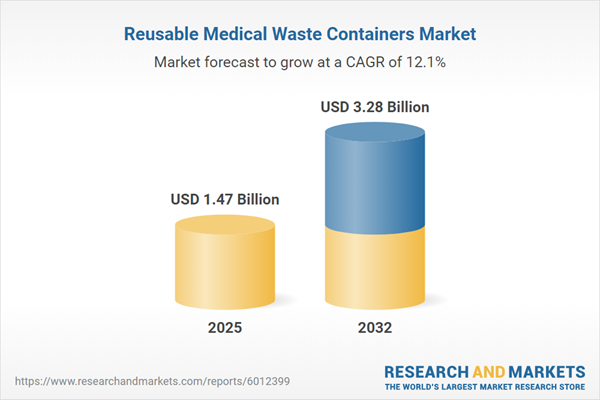Speak directly to the analyst to clarify any post sales queries you may have.
The reusable medical waste containers market is rapidly evolving, offering healthcare organizations reliable ways to achieve safety, compliance, and environmental objectives amidst changing regulations and growing sustainability demands.
Market Snapshot: Reusable Medical Waste Containers Market Growth and Outlook
The reusable medical waste containers market grew from USD 1.31 billion in 2024 to USD 1.47 billion in 2025 and is projected to maintain a CAGR of 12.05%, reaching USD 3.28 billion by 2032. Adoption is driven by intensifying regulatory scrutiny, increased demand for sustainability, and the need for cost-effective solutions. Stakeholders invest in material advancements, sterilization optimization, and digital integration, positioning reusable systems as a long-term alternative to single-use options.
Scope & Segmentation
- End Users: Ambulatory centers, dialysis centers, surgical centers, clinics, hospitals, laboratories, diagnostic laboratories, research laboratories, and long-term care facilities.
- Waste Types: Chemical waste, infectious waste, microbiological waste, pathological waste, pharmaceutical waste, radioactive waste, and sharps.
- Container Types: Bins, carts, hard shell containers (polyethylene, polypropylene), and soft bag containers (high-density polyethylene, low-density polyethylene).
- Material Types: Composite, metal, plastic (high-density polyethylene, polypropylene).
- Distribution Channels: Direct sales, local distributors, national distributors, online retail (company website, third-party platform).
- Container Sizes: Large, medium, and small capacity.
- Sterilization Methods: Autoclave, chemical treatment, irradiation.
- Geographic Regions: Americas (North America, Latin America), Europe, Middle East & Africa, Asia-Pacific, including country-specific analyses such as United States, Germany, China, and others.
Key Takeaways for Decision-Makers
- Healthcare organizations are prioritizing reusable containers to align with circular economy goals while maintaining strict safety and compliance standards.
- Sensor-enabled and automated containers are enabling real-time monitoring of fill levels and sterilization cycles, enhancing operational transparency.
- Partnerships among healthcare providers, manufacturers, and waste management services are creating integrated solutions tailored to site-specific needs.
- Material innovations are focused on enhancing container durability for repeated sterilization cycles, optimizing lifecycle costs and reducing waste.
- Stakeholders in high-volume environments, such as surgical and dialysis centers, are early adopters due to rigorous infection control protocols.
- Regional variations in regulatory compliance, infrastructure, and investment priorities shape different adoption patterns and technology demands across markets.
Tariff Impact: Navigating Cost Structure Shifts
With new tariffs scheduled for implementation in the United States in 2025, manufacturers and distributors can anticipate added cost pressures on imported containment solutions. This development has led organizations to explore nearshoring, strategic stockpiling, and stronger partnerships with domestic producers to stabilize supply chains, offset rising expenses, and encourage local manufacturing growth.
Methodology & Data Sources
This report applies a rigorous mixed methods approach, combining secondary research with in-depth stakeholder interviews. The analysis draws on regulatory documents, industry publications, academic literature, and direct insights from healthcare facility managers, infection control specialists, manufacturers, and waste service providers. Data triangulation and scenario analysis strengthen the reliability of segmentation, regional, and competitive findings.
Why This Report Matters
- Supports strategic planning by mapping the evolving interplay between regulatory frameworks, technology innovations, and market segmentation in the reusable medical waste containers market.
- Enables procurement, sustainability, and operational leaders to pinpoint investment opportunities and manage supply chain risks associated with market and policy changes.
- Provides actionable recommendations for deploying smart technology, building resilient supply networks, and fostering cross-functional collaboration to enhance compliance and efficiency.
Conclusion
As the reusable medical waste containers sector continues to innovate, healthcare organizations benefit from deeper strategic insights for adopting scalable, sustainable containment solutions. Comprehensive analysis empowers leaders to drive efficiency, cost savings, and regulatory alignment in the evolving global landscape.
Additional Product Information:
- Purchase of this report includes 1 year online access with quarterly updates.
- This report can be updated on request. Please contact our Customer Experience team using the Ask a Question widget on our website.
Table of Contents
3. Executive Summary
4. Market Overview
7. Cumulative Impact of Artificial Intelligence 2025
Companies Mentioned
The companies profiled in this Reusable Medical Waste Containers market report include:- Stericycle, Inc.
- Clean Harbors, Inc.
- Veolia Environnement S.A.
- Daniels Health Australia Pty Ltd.
- Sharps Compliance, Inc.
- Becton, Dickinson and Company
- Cardinal Health, Inc.
- McKesson Corporation
- Owens & Minor, Inc.
- Medline Industries, L.P.
Table Information
| Report Attribute | Details |
|---|---|
| No. of Pages | 187 |
| Published | October 2025 |
| Forecast Period | 2025 - 2032 |
| Estimated Market Value ( USD | $ 1.47 Billion |
| Forecasted Market Value ( USD | $ 3.28 Billion |
| Compound Annual Growth Rate | 12.0% |
| Regions Covered | Global |
| No. of Companies Mentioned | 11 |









